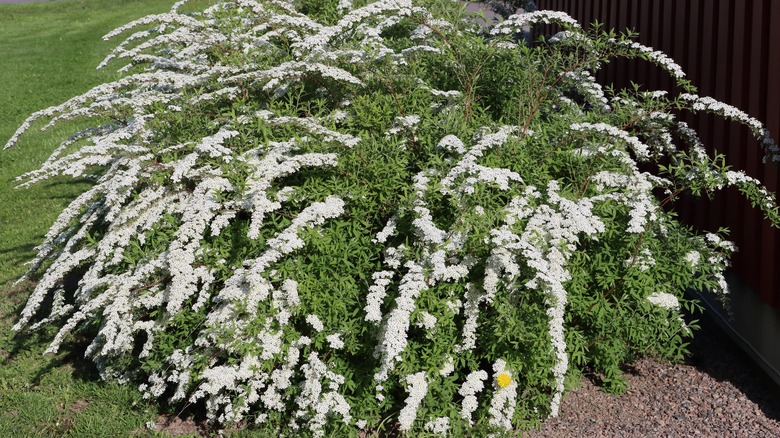Tricks For Pruning Your Spirea Bushes To Keep Them Looking Neat
If you have established spirea bushes growing in your garden, you'll want to know how to prune them effectively so that they look nice and neat, and not overgrown and messy. Bear in mind, though, that some spirea species are regarded as being invasive and should not be planted in your garden. Nevertheless, if you already have one of these growing in your yard, proper pruning and maintenance — like removing suckers — can help to contain your plant and make it more manageable.
The Invasive Plant Atlas lists Japanese spirea (Spiraea japonica) as a major invasive species because it creates a dense thicket that can crowd out native species. Other invasive varieties listed in the Invasive Plant Atlas include Thunberg's meadowsweet (Spiraea thunbergii), Bridalwreath spirea (Spiraea prunifolia), and Vanhoutte spirea (Spiraea x vanhouttei). The problem with these species is that they're not only self-seeding, but can also spread by underground suckers. Even hybrids or cultivars, such as gold mound spirea, have this spreading tendency. While gold mound spirea might be one of the shrubs that are perfect for full sun areas in your yard, you do need to keep it well maintained with regular pruning.
If left to their own devices, spirea shrubs can grow quite aggressively and start to look overgrown and scraggly. This detracts from how nicely maintained they could look if proper pruning techniques are used. Here are some tips and tricks for pruning your spirea so that they look well-cared for.
Prune your spirea bushes at least twice a year
To keep your spirea's growth in check and promote a neat appearance, you should prune it at least twice a year. Ideally, you want to prune your plant as soon as it's finished flowering. Depending on the species you're growing, this could be in late spring or mid-summer. If you trim back the branches that have just flowered to a new set of leaf buds, you may find that your spirea will flower for a second time later in the season. Remove any dead branches or old canes. Cut these right back to the base of the plant. This also helps to increase airflow throughout the plant and stops fungal diseases from taking hold
Your second pruning should be done either in the fall after leaf drop or in late spring. Spring blooming spiraeas are one of those plants that you shouldn't be pruning in the fall, because they produce flowers on old wood. These should be pruned in late spring. But summer blooming varieties are safe to prune in the fall or winter, because they will bloom on new wood. Make sure you remove any dead branches right down to the base of the plant. You'll find that deciduous plants like spiraeas will produce their new growth near the top half of the branches, and if you don't remove some of the older or dead branches, you're just going to have a mass of bare branches around the bottom half.
How to rejuvenate an overgrown spirea
If you've just moved into your home and you've inherited an overgrown spirea, all is not lost. You can actually rejuvenate the plant with a heavy prune in winter or early spring and it will reward you with lush new growth and an abundance of flowers. Here's what to do.
Take your pruning shears and cut back all the growth to around 2 to 3 feet above the ground. At the same time, remove as many dead branches as you can. Cut these right down to the ground. You can also selectively remove some of the older canes to open up the interior of the plant. After you do this, it might take a couple of years for your plant to reach its full glory again, but you'll find it much more attractive and manageable in the meantime.
For a really old spirea that's been neglected for many years, you can be even more aggressive and cut the whole thing back to around 12 inches from the ground. In fact, this is the best way to tame your overgrown shrubs, according to Colorado State University Extension. It might take a while for the plant to spring back and regrow, but this heavy pruning is unlikely to kill it. Remember that during the active growing season, you can give your spirea a light pruning if you notice that some branches are overgrowing. Just trim these back to a set of leaf buds to keep your plant tidy.


